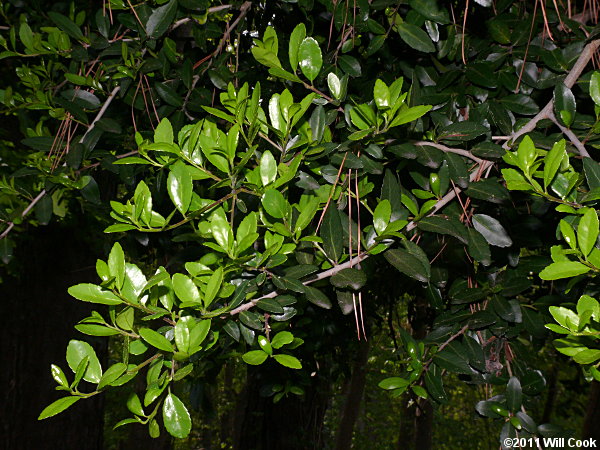
| Yaupon is a small evergreen holly tree native to the coastal plain of the southeastern US, especially common in maritime forests. Yaupon is also widely naturalized in the Piedmont, particularly in the Durham area, and usually occurs at the edges of woods. Durham, NC 4/14/2011.
| 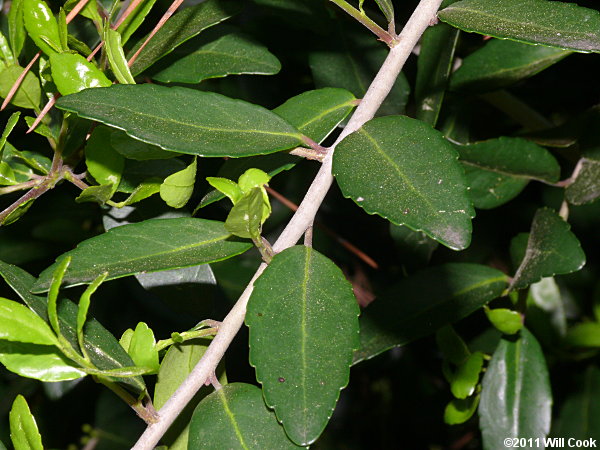
| The small, elliptic leaves are thick, have crenate margins, and are glossy above. The young leaves contain caffeine and may be used to make a delicious tea, which is comparable to the yerba mate (Ilex paraguariensis) that Argentinians drink in copious amounts. The tea is a fine drink — don't be put off by the scientific name vomitoria, which refers to the effect of drinking gallons of tea at a sitting (as was done during purification rituals) or eating its fruits. Read a historical account of the tea use from John Lawson below. Durham, NC 4/14/2011.
| 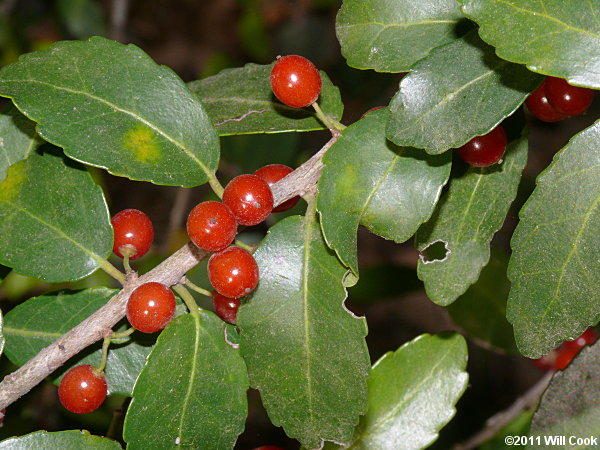
| The fruits, which technically are drupes, not berries, are bright red and last through the winter. The fruits are emetic. Austin, Travis Co., TX 4/29/2011.
| 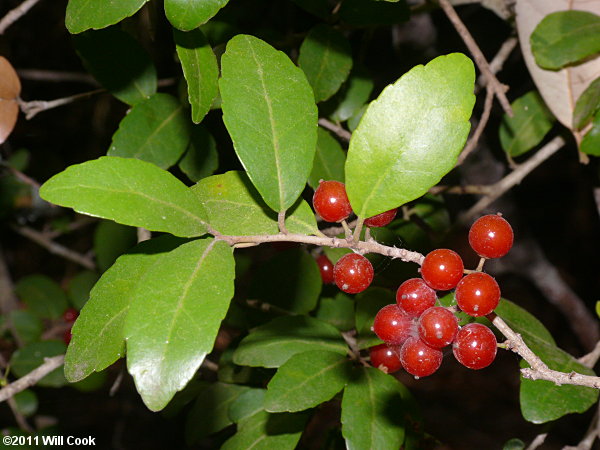
| Austin, Travis Co., TX 4/29/2011.
|
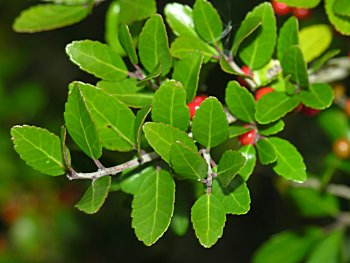
| Dare Co., NC 11/11/06.
| 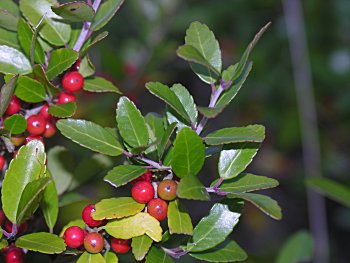
| Dare Co., NC 11/11/06.
| 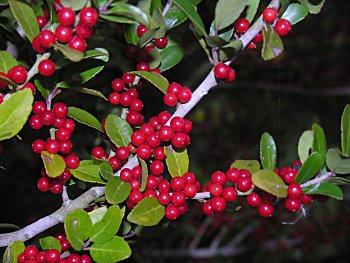
| Dare Co., NC 11/11/06.
| 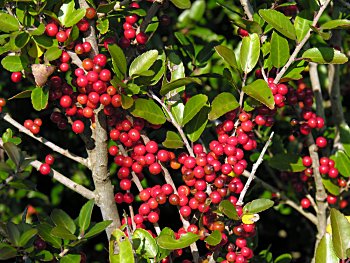
| Yaupons are stunning when in full fruit, one of our best native ornamentals. Dare Co., NC 11/11/06.
| 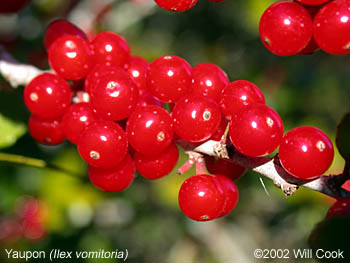
| Bright red ripe drupes. Dare Co., NC 1/26/02.
| 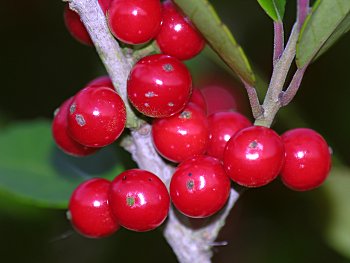
| The leaf margins are revolute (turned under), as you can see here. Note also that the twigs and petioles are puberulent (minutely hairy). Dare Co., NC 11/11/06.
|
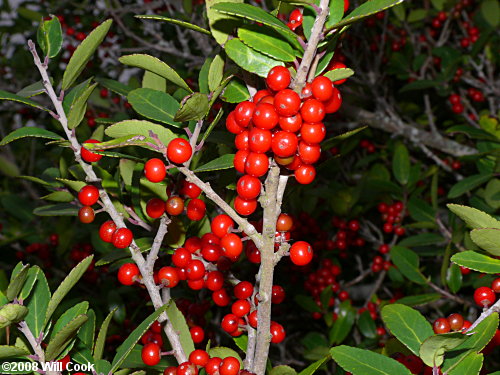
| Dare Co., NC 11/7/08
| 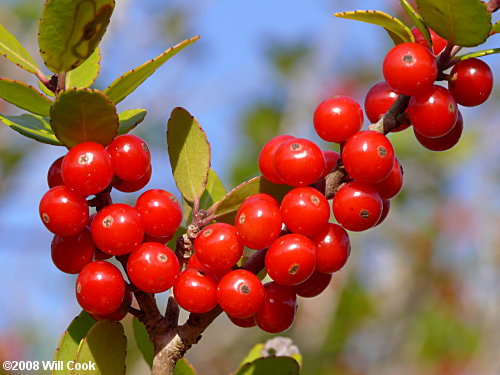
| Dare Co., NC 11/7/08.
| 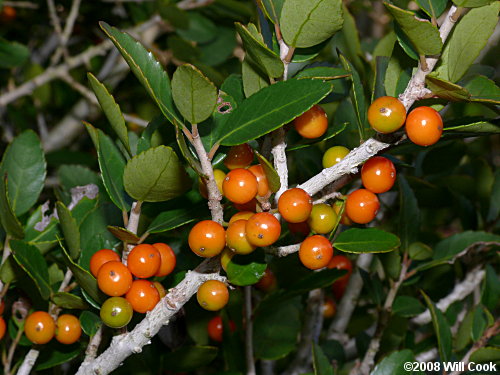
| Ripening drupes. The drupes are rarely yellow or orange when ripe. Dare Co., NC 11/7/08.
|
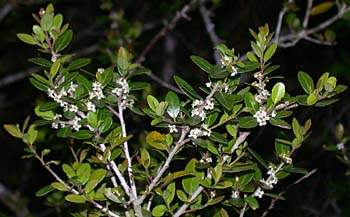
| Flowering, Carteret Co., NC, 4/20/02.
| 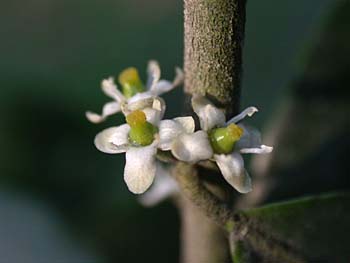
| Female flowers. Hollies are dioecious — trees have either male or female flowers. Durham, NC 5/4/04.
|
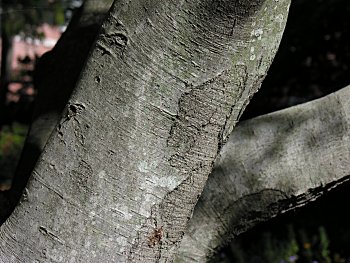
| Bark of a mature tree. The bark is smooth, like that of other hollies. Durham, NC 10/15/06.
|
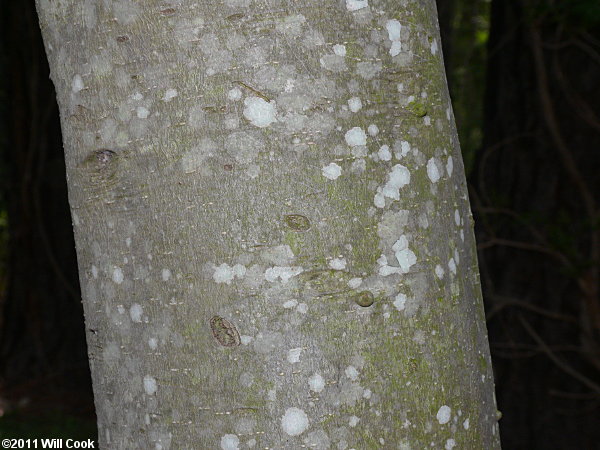
| Durham, NC 4/14/2011.
|
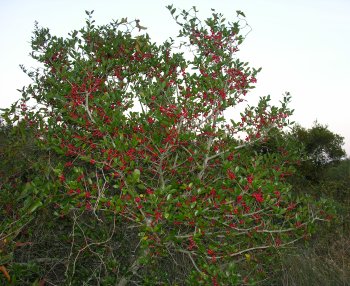
| Yaupon is generally a small tree or large shrub with an irregular, but attractive, form. Dare Co., NC 11/11/06.
| 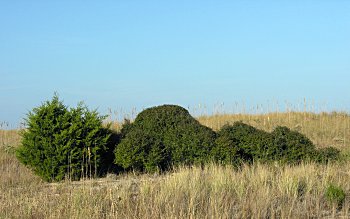
| In coastal dunes it is pruned by the wind into low mounds (right). The small tree on the left is Southern Redcedar. Dare Co., NC 11/11/06.
|
More information:
Trees of Alabama and the Southeast
NC State Fact Sheets: Trees | Poisonous Plants
Virginia Tech Dendrology
John Lawson's account of Yaupon in Carolina
|

| Below is a passage from John Lawson's book "A New Voyage to Carolina; Containing the Exact Description and Natural History of that Country: Together with the Present State therof" (1709). The book is a must-read for anyone interested in the natural history or human history of the Carolinas. You can read it online here or click on the image at left to buy it new.
|
Last of Bushes, (except Savine, which grows every where wild) is the famous Yaupon, of which I find two sorts, if not three. I shall speak first of the Nature of this Plant, and afterwards account for the different Sorts. This Yaupon, call'd by the South-Carolina Indians, Cassena, is a Bush, that grows chiefly on the Sand-Banks and Islands, bordering on the Sea of Carolina; on this Coast it is plentifully found, and in no other Place that I know of. It grows the most like Box, of any Vegetable that I know, being very like it in Leaf, only dented exactly like Tea, but the Leaf somewhat fatter. I cannot say, whether it bears any Flower, but a Berry it does, about the Bigness of a grain of Pepper, being first red, then brown when ripe, which is in December; Some of these Bushes to be twelve Foot high, others are three or four. The Wood thereof is brittle as Myrtle, and affords a light ash-color'd Bark. There is sometimes found of it in Swamps and rich low Grounds, which has the same figured Leaf, only it is larger, and of a deeper Green; This may be occasion'd by the Richness that attends the low Grounds thus situated. The third Sort has the same kind of Leaf, but never grows a Foot high, and is found both in rich, low Land, and on the Sand-Hills. I don't know that ever I found any Seed, or Berries on the dwarfish Sort, yet I find no Difference in Taste, when Infusion is made: Cattle and Sheep delight in this Plant very much, and so do the Deer, all which crop is very short, and browze thereon, wheresover they meet with it. I have transplanted the Sand-Bank and dwarfish Yaupon, and find that the first Year, the Shrubs stood at a stand; but the second Year they throve as well as in their native Soil. This Plant is the Indian Tea, us'd and approv'd by all the Savages on the Coast of Carolina, and from them sent to the Westward Indians, and sold at a considerable Price. All which they cure after the same way, as they do for themselves; which is thus: They take this Plant (not only the Leaves, but the smaller Twigs along with them) and bruise it in a Mortar, till it becomes blackish, the Leaf being wholly defaced: Then they take it out, put it into one of their earthen Pots which is over the Fire, till it smoaks; stirring it all the time, till it is cur'd. Others take it, after it is bruis'd, and put it into a Bowl, to which they put live Coals, and cover them with the Yaupon, till they have done smoaking, often turning them over. After all, they spread it upon their Mats, and dry it in the Sun to keep it for Use. The Spaniards in New-Spain have this Plant very plentifully on the Coast of Florida, and hold it in great Esteem. Sometimes they cure it as the Indians do; or else beat it to a Powder, so mix it, as Coffee; yet before they drink it, they filter the same. They prefer it above all Liquids, to drink with Physick, to carry the same safely and speedily thro' the Passages, for which it is admirable, as I myself have experimented.
|
Recommended Tree, Shrub, and Woody Vine Identification Guides
|
|



















